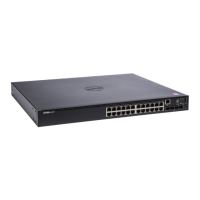Switch Management Commands 2240
User Guidelines
This command has no user guidelines.
Example
Following is an example of using the telnet command to connect to
176.213.10.50.
console#telnet 176.213.10.50
Trying 176.213.10.50...
Connected to 176.213.10.50
Entering character mode...
Escape character is'^^'.
traceroute
Use the traceroute command to discover the routers that packets traverse
when traveling to their destination.
Syntax
traceroute [vrf vrf-name] [ip] ipaddress|hostname [init-ttl initTtl] [max-ttl
maxTtl] [max-fail maxFail] [interval interval] [count count] [port port]
[size size][source {src-ip-address|vlan vlan-id|loopback loopback-id}]
• vrf-name—The name of the VRF associated with the routing table
context used by the command. If no vrf is specified, the global routing
table context is used.
• ipaddress—Valid IP address of the destination host.
• hostname—Hostname of the destination host. (Range: 1–158
characters). The command allows spaces in the host name when
specified in double quotes. For example, console(config)#snmp-
server host “host name”
• initTtl—The initial time-to-live (TTL); the maximum number of router
hops between the local and remote system (Range: 1–255).
• maxTtl—The largest TTL value that can be used (Range:1–255).
• maxFail—Terminate the traceroute after failing to receive a response for
this number of consecutive probes (Range: 1–255).

